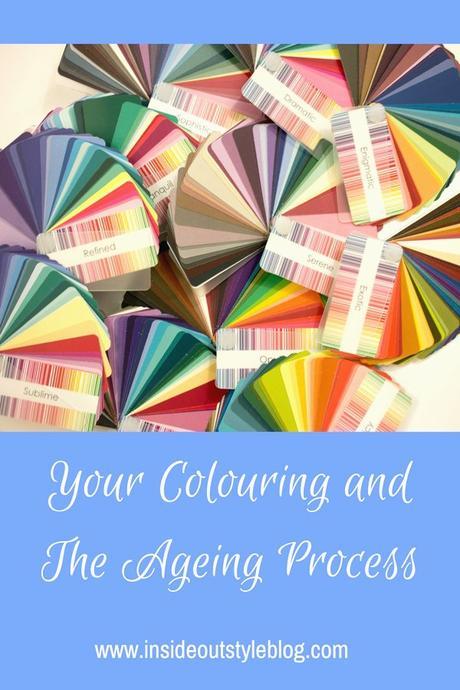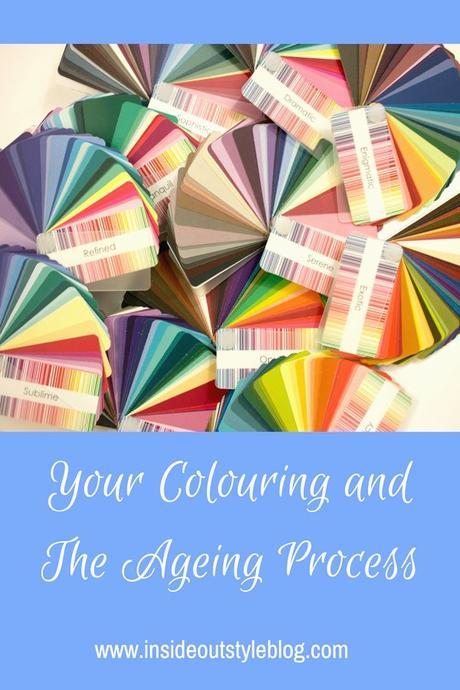The ageing process changes many aspects of your life, from body, to lifestyle and how you approach style. And then of course there is colouring too, which is the topic of the video in this post as Jill Chivers of Shop Your Wardrobe and I discuss how colouring changes with the ageing process (and show you the steps that you may take as part of your colouring changes).
Colouring Changes that May Happen with Age
Hair and Skin Colour Changes
Your hair may lighten as it greys and may even go white eventually.
This means, your hair is not as bright as it once was as it greys or loses its pigments.
You may choose to colour it, but will find that your skin colour along with your hair and that you need to reassess which colours suit the skin you have now (rather than the skin you used to have). The "natural" colour your hair was at 20 is unlikely to suit you as well at the age of 50 as you no longer have the skin you had a 20.
Having lighter hair may mean that you need to lighten up your wardrobe (just as I have done since going from brunette to blonde - and you can read about my hair colour journey here).
Contrast Levels Change
You may lose your value contrast if your hair was once dark and becomes light. This means you may move from a high value contrast to a medium or low one, so needing to change how you put your colours and outfits together.
For me this made me think really hard each morning when getting dressed, as my old 'formula' had to be replaced with a new one.
Your colour contrast may change too - particularly if you had a coloured hair and it ends up grey which is a neutral.
Find out more about contrast and understanding your contrast here.
Your Best Neutrals May Change
If you have had darker hair you will find that darker neutrals are best through your life, and suddenly as your hair lightens they just don't harmonise as well.
As your hair becomes lighter you will find that lighter neutrals work better for you and you may need to rethink your neutral staples.
If you had brown hair, brown would have been a great neutral (a brown that is similar to your hair colour).
If you now have grey hair, then greys become a better neutral for you.
For me, as I changed into a light platinum blonde, white is now my new black.
Your Intensity Will Change
If you started off with brighter colouring, clearer skin and an intense hair colour such as a golden blonde, copper, black or darker brown, as you age and your hair goes grey your skin will also become softer and more muted and you will find that softer more smoky colours will suit you more.
In the video I show you the progression you may take from brighter colours to more muted.
This is why it's worth getting a new colour analysis every 10 years or if you make a radical hair colour change as this will influence the colours that suit you now (rather than what suited you in the past).
If you need help in discovering the colours that suit you today, this is one part of my 7 Steps to Style program which will give you all the tools and information you need to keep developing and improving your style into the decades to come. Find out more here.
More Tips on Colour and Ageing
How Your Colouring Changes as You Age
Style and Taste at Every Age - Quality
There is No Age Limit to Style
How Does Your Colouring Change As You Age?
How to Choose a Hair Colour as You Age
Going Blonde - Choosing the Right Shade
Understanding Undertone and Ageing - Warm to Cool

The ageing process changes many aspects of your life, from body, to lifestyle and how you approach style. And then of course there is colouring too, which is the topic of the video in this post as Jill Chivers of Shop Your Wardrobe and I discuss how colouring changes with the ageing process (and show you the steps that you may take as part of your colouring changes).
Colouring Changes that May Happen with Age
Hair and Skin Colour Changes
Your hair may lighten as it greys and may even go white eventually.
This means, your hair is not as bright as it once was as it greys or loses its pigments.
You may choose to colour it, but will find that your skin colour along with your hair and that you need to reassess which colours suit the skin you have now (rather than the skin you used to have). The "natural" colour your hair was at 20 is unlikely to suit you as well at the age of 50 as you no longer have the skin you had a 20.
Having lighter hair may mean that you need to lighten up your wardrobe (just as I have done since going from brunette to blonde - and you can read about my hair colour journey here).
Contrast Levels Change
You may lose your value contrast if your hair was once dark and becomes light. This means you may move from a high value contrast to a medium or low one, so needing to change how you put your colours and outfits together.
For me this made me think really hard each morning when getting dressed, as my old 'formula' had to be replaced with a new one.
Your colour contrast may change too - particularly if you had a coloured hair and it ends up grey which is a neutral.
Find out more about contrast and understanding your contrast here.
Your Best Neutrals May Change
If you have had darker hair you will find that darker neutrals are best through your life, and suddenly as your hair lightens they just don't harmonise as well.
As your hair becomes lighter you will find that lighter neutrals work better for you and you may need to rethink your neutral staples.
If you had brown hair, brown would have been a great neutral (a brown that is similar to your hair colour).
If you now have grey hair, then greys become a better neutral for you.
For me, as I changed into a light platinum blonde, white is now my new black.
Your Intensity Will Change
If you started off with brighter colouring, clearer skin and an intense hair colour such as a golden blonde, copper, black or darker brown, as you age and your hair goes grey your skin will also become softer and more muted and you will find that softer more smoky colours will suit you more.
In the video I show you the progression you may take from brighter colours to more muted.
This is why it's worth getting a new colour analysis every 10 years or if you make a radical hair colour change as this will influence the colours that suit you now (rather than what suited you in the past).
If you need help in discovering the colours that suit you today, this is one part of my 7 Steps to Style program which will give you all the tools and information you need to keep developing and improving your style into the decades to come. Find out more here.
More Tips on Colour and Ageing
How Your Colouring Changes as You Age
Style and Taste at Every Age - Quality
There is No Age Limit to Style
How Does Your Colouring Change As You Age?
How to Choose a Hair Colour as You Age
Going Blonde - Choosing the Right Shade
Understanding Undertone and Ageing - Warm to Cool




